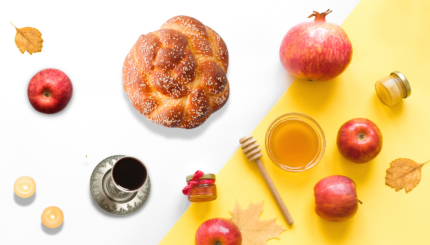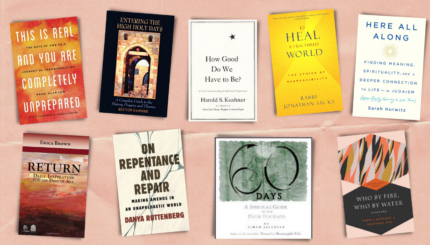This is the time to know our own song, to allow the echoes of our thoughts, words, and actions of this past year to ripple through us, awakening knowledge and power for the song that is yet to be born.
In “facing the music,” I hear the hesitant strains of my own broken dreams. I wince at the dissonance between intention and deed, between ecstatic ideal and sober reality. I listen carefully to tone and timber. Where have I been half-hearted in my loving? I listen for harmony and counterpoint. Where have I created discord with my argument or complaint? And I notice pitch. How carefully have I listened? As I follow the line of my own melody, I ask, “Where is this leading me?”
This song of my life makes a deep groove, and the record will play over and over and over again. The mind weaves an endless loop. repeating mistakes, like bad jingles or notes that fall forever flat without lilt or vigor.
Yet on these High Holy Days we are given a reprieve from the oppression of habit. We are give the chance to “annul the severity of the judgment,” which means to stop the song, to hear its complex rhythms and beauty, and to begin to sing again, altering the pattern of this song so that its melody will birth a new singer.
With your help, My Jewish Learning can provide endless opportunities for learning, connection and discovery.
And how is this miracle accomplished? We are given a score consisting of three components. Tefillah, Teshuvah, and Tzedakah are the essential instruments necessary for the re-creation of the Song which is the flow of life.
This is the time when [in the words of the Unetanah Tokef prayer], “The great Shofar is sounded, and a still small voice is heard.”
“The great Shofar is sounded ,”…. bringing each of these instruments to life. “And a still small voice is heard, “…. calling forth new life, hope, promise, and vision.
Tefillah : Prayer as Transformation
Each time I face a community coming together for prayer, the question of why we are here and what we are doing hangs in the air. The outer reasons (all fine) of comfort, nostalgia, belonging, creed somehow will not suffice. Something in me yearns to go beyond the known….to be transformed…to die and to be reborn.
Prayer is the path that leads me into the Void, into the silence, into Ayin [nothingness], which is the source of infinite potential. The words of prayer must point me towards that nothingness, and the beauty of prayer exists to inspire in me the courage to ” let go” completely.
In letting go of life, expectations, identity, boundaries, belief, certainty, and content, I am set free from the chains of the past. Then I can allow the power of re-creation to surprise me. All of the power of prayer–memory, regret, vision, commitment–can be dedicated in trust to this process of transformation.
Teshuvah : The Art of Response
The second key is teshuvah, a word usually translated as repentance or return. It also means response, and in that meaning I find instruction guiding me towards a certain stance in relation to my life.
When the “great shofar is sounded”…”the still small voice” emerges as my response. The art of response requires listening, which necessitates the cultivation of a patient, calm receptive presence. I don?t mean listening as a passive bystander. The kind of listening I?m talking about is when you allow yourself to be addressed directly; it means “taking it personally.”
When I walk outside and look up at the sky, I can open myself to receive its blue as a gift or as a letter that is addressed to me. Its beauty calls forth a response–gratefulness, praise, wonder. Something in me rises to meet that presence which calls to me through the purity of Blue.
And when I encounter suffering in the world, I can let its mystery address me, calling forth compassion from my own depths. Response is an art form that requires opening, listening and knowing oneself and one?s reactions. Responsibility is the freedom to respond wisely, rather than be enslaved by patterns of reaction.
Tzedakah : Living out the Implications of Mysticism
Justice, righteousness, or charity are usually understood as actions governed by rules that are imposed from without. Yet all of us have had powerful experiences that transcend our usual perception of separateness and plant deep within us a seed of the truth of our essential unity and interconnectedness. It is the seed of tzedek, of righteousness. Most often that seed is ignored, belittled, compartmentalized, mystified, kept secret, or forgotten.
What can I do in the world that will be consistent with the vision of unity that I had? How do I relate to strangers knowing that we are intimately bound? How shall the implications of the peak unfold in my daily lowland wanderings?
That flash of knowing is like “the great shofar” that is sounded, an encounter with mystery. And then “the still small voice” calls me to live in the truth of my encounter, in the illumination of that flash.
Facing the Music
The time has come to face the music. At Mount Sinai we heard the lightning and saw the thunder. Facing the music is like seeing the thunder. It is stepping back from the narrowness of normal sense perception that merely sees sights and hears sounds. Revelation happens beyond the confines of “normal” mind which tries to figure it out and make sense.
May these holy days take each of us high and deep, beyond the tired old song, and may the music we find coming through us in the year ahead be an inspiration for all.
Reprinted with permission from the website of the Shalom Center.
shofar
Pronounced: sho-FAR or SHO-far, Origin: Hebrew, a ram’s horn that is sounded during the month of Elul, on Rosh Hashanah, and on Yom Kippur. It is mentioned numerous times in the Bible, in reference to its ceremonial use in the Temple and to its function as a signal-horn of war.



